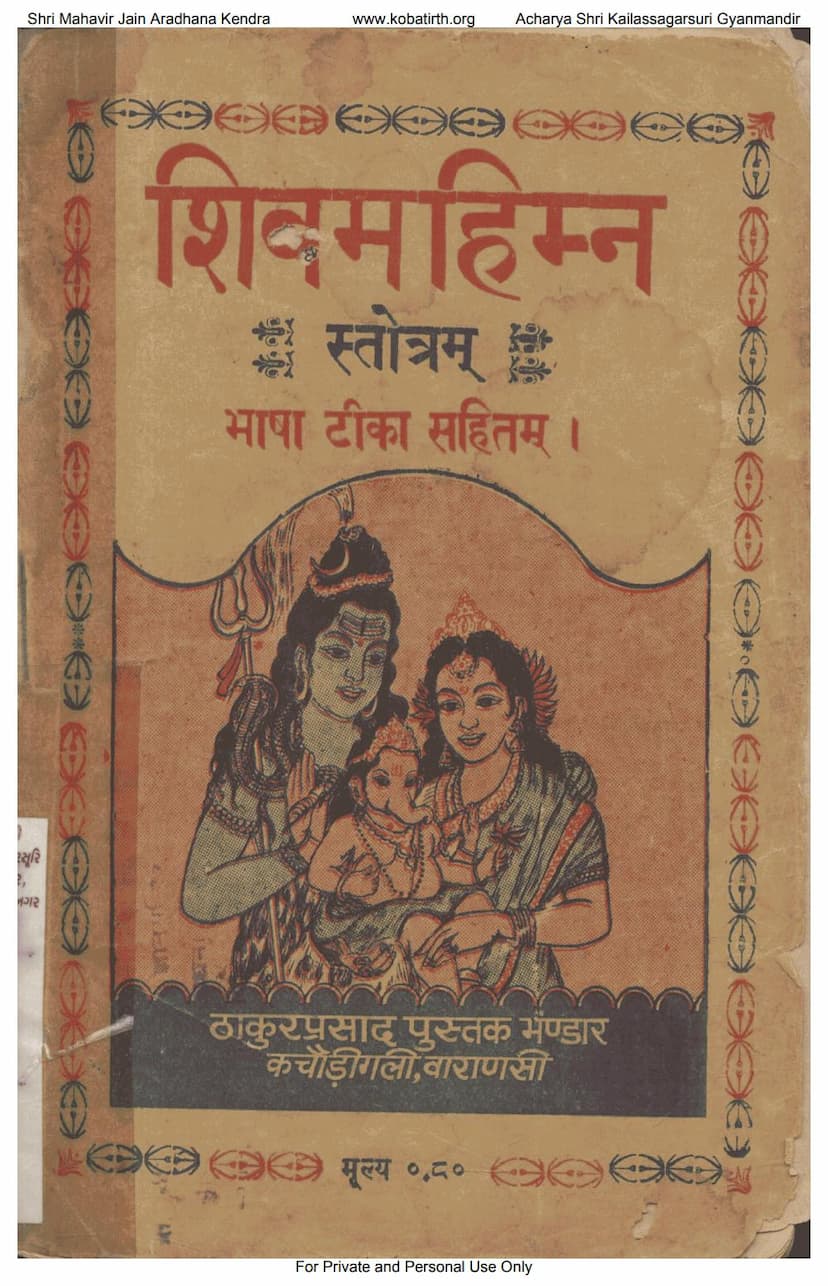Shiv Mahimna Stotram
Added to library: September 2, 2025

Summary
This document is the Hindi-language edition of the Shiv Mahimna Stotram, published by Thakurprasad Pustak Bhandar. The provided text includes the stotram itself, along with a detailed Hindi commentary (Bhasha Teeka). It also features related devotional texts such as the Shiva Tandava Stotram by Ravana, Shiva Stuti by Goswami Tulsidas, Shiva Panchakshara Stotram, and Pashupati Ashtakam.
The core of the document is the Shiv Mahimna Stotram, a devotional hymn praising the greatness and glory of Lord Shiva. The commentary explains each verse in detail, aiming to make the profound philosophical and theological concepts accessible to the reader.
Here's a breakdown of the key themes and content:
Shiv Mahimna Stotram (and its commentary):
- Incomprehensibility of Shiva's Greatness: The stotram begins by acknowledging that even Brahma and other deities cannot fully comprehend Shiva's infinite glory, let alone the humble devotee. The verses explore the limitations of human language and intellect in describing the divine.
- Shiva's Role in Creation, Preservation, and Destruction: The hymn highlights Shiva's omnipotence and his active role in the cosmic cycles of creation, sustenance, and dissolution of the universe.
- Philosophical Debates and Shiva's Supremacy: The stotram addresses various philosophical schools of thought (like Sankhya, Yoga, Shaivism, Vaishnavism) and asserts Shiva's ultimate supremacy over all of them, comparing him to the ocean that all rivers flow into.
- Shiva's Unique Attributes and Forms: The text describes Shiva's distinctive iconography, including his trident, the crescent moon on his head, the Ganges flowing from his matted locks, his ash-smeared body, his association with cremation grounds, and his animal mount (Nandi). The commentary explains the symbolic meaning behind these attributes.
- Devotion as the Path to Salvation: A recurring theme is the power of sincere devotion and surrender to Shiva as the means to attain liberation and spiritual fulfillment. The stotram recounts instances of devotees like Ravana and Vishnu who achieved great feats or divine favor through their devotion.
- Transcendence of Attributes: Despite his cosmic activities and associations, Shiva is portrayed as being beyond all material qualities and limitations (nirguna).
- The Origin of the Stotram: The text mentions that the stotram was composed by Pushpadanta, a Gandharva, who was humbled by Shiva.
- Benefits of Reciting the Stotram: The document emphasizes the spiritual and material benefits of reciting the Shiv Mahimna Stotram regularly, including attaining Shiva's abode, living a virtuous life, and achieving prosperity.
Other Included Texts:
- Shiva Tandava Stotram by Ravana: This is a powerful and dynamic hymn describing Shiva's cosmic dance (Tandava) with great fervor and vivid imagery. The commentary explains Ravana's supplication to Shiva for success.
- Shiva Stuti by Goswami Tulsidas: This section includes devotional verses in the style of Tulsidas, praising Lord Shiva's divine qualities and seeking his blessings.
- Pashupati Ashtakam: An eight-verse hymn dedicated to Pashupati (Lord of animals/herdsmen), praising his role as the controller of the universe and the remover of devotees' sufferings.
- Shiva Panchakshara Stotram: This stotram focuses on the five sacred syllables "Na-Ma-Shi-Va-Ya," which represent Lord Shiva. Each verse elaborates on one syllable and its significance.
Publisher and Context:
The publication details indicate that this is a comprehensive edition intended for personal and private use, likely for religious practice and study within the Jain tradition, as suggested by the associated Jain centers and affiliations mentioned in the page headers. Despite the title focusing on Shiva, the Jain context suggests an appreciation for universal spiritual principles and perhaps a syncretic approach to devotional literature.
In essence, this document is a rich compilation of Shiva-centric devotional literature, offering a deep dive into the philosophical and devotional aspects of worshipping Lord Shiva, presented with detailed Hindi explanations.